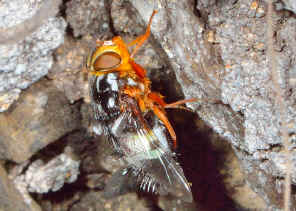|
| |
Family
Tachinidae
- This page contains pictures and information about Black and White Giant
Flies that we found in the Brisbane area, Queensland, Australia.
-
 - Body length 20mm
-
- Black and White Giant Fly is a very large size attractive fly with metallic
black and white colours. The head is golden orange. The abdomen has
stout spiniform setae at all directions. Abdomen segment 5 is short and
broad, with well formed median depression and prominent posterior corners.
All legs are orange in colour
-


 -
- We found this
Black and White Giant Fly once on Nov 2012 in
Karawatha Forest on Rocky Track. We knew this fly from reference
information long time ago. We knew this is the very large handsome fly and
they can be seen in Brisbane. We had no luck on seeing them until yesterday
(Nov 2012). In the
Karawatha Forest we noticed a newly fallen large gum tree trunk. We expected
to find something interesting near the base of the tree trunk. To our
surprise, we saw a very large fly hovering and checking the mud wall
attached to the fallen tree trunk. We were very happy to find that it is the
Black and White Giant Fly.
-


 -
- Black
and White Giant Fly flies with a medium loud buzzing sound. The fly was
hovering forwards and backwards. Every time it came forwards, it hit the mud
wall with quite a loud sound. It repeated doing this a few times then have a
few seconds short rest, then repeated the actions again. We believed the fly
was checking if there were any soil dwelling Scarabaeidae
larvae under the soil.
-



-
- All Tachinid Flies share the
parasitoid habit. Their larvae are internal parasites of many orders and families of insects.
The Fly in tribe Rutiliini mostly are parasitic in larval Coleoptera
(beetle) especially Scarabaeidae.
The reference information suggested that the Black and White Giant Fly may
parasite on the larvae of beetles in Cetoniinae.
-
- For the general information about Tachinid
fly in tribe Rutiliini, please check this page.
-
- Reference:
- 1. A revisionary classification of the Rutiliini (Diptera: Tachinidae), : with keys to the described species - R. W. Crosskey, British Museum (Natural History),
Bulletin, Entomology, Supplement 19, 1973.
- 2. A conspectus of the Tachinidae (Diptera) of Australia, including keys to the supraspecific taxa and taxonomic and host catalogues - R. W. Crosskey, British Museum (Natural History),
Bulletin, Entomology, Supplement 21, 1973.
- 3. Species
Formosia (Euamphibolia) speciosa (Erichson, 1842) - Australian Biological Resources Study, Australian Faunal Directory.
- 4. Insects
of Australia, CSIRO, Division of Entomology, Melbourne University
Press, 2nd Edition 1991, p 784, plate 5O.
- 5. Insects of Australia and New Zealand - R. J. Tillyard, Angus
& Robertson, Ltd, Sydney, 1926, p376, plate 25.27 (Euamphibolia
fulvipes).
-
- Back to Top
-
- [ Up ] [ Black and White Rutilia Fly ] [ Blue Rutilia Fly ] [ Golden Head Rutilia Fly I ] [ Golden Head Rutilia Fly II ] [ Golden Head Rutilia Fly III ] [ Green Rutilia Fly I ] [ Green Rutilia Fly II ] [ Green Rutilia Fly III ] [ Grey Rutilia Fly I ] [ Grey Rutilia Fly II ] [ Grey Rutilia Fly III ] [ Grey Rutilia Fly IV ] [ Brown Rutilia Fly ]
| |
|










